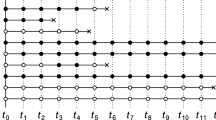Abstract
Reuse of controls in a nested case–control (NCC) study has not been considered feasible since the controls are matched to their respective cases. However, in the last decade or so, methods have been developed that break the matching and allow for analyses where the controls are no longer tied to their cases. These methods can be divided into two groups; weighted partial likelihood (WPL) methods and full maximum likelihood methods. The weights in the WPL can be estimated in different ways and four estimation procedures are discussed. In addition, we address modifications needed to accommodate left truncation. A full likelihood approach is also presented and we suggest an aggregation technique to decrease the computation time. Furthermore, we generalize calibration for case-cohort designs to NCC studies. We consider a competing risks situation and compare WPL, full likelihood and calibration through simulations and analyses on a real data example.
Similar content being viewed by others
References
Barlow WE (1994) Robust variance estimation for the case-cohort design. Biometrics 50(4): 1064–1072
Borgan Ø, Goldstein L, Langholz B (1995) Methods for the analysis of samled cohort data in the Cox proportional hazards model. Ann Stat 23(5): 1749–1778
Breslow NE, Lumley T, Ballantyne CM, Chambless LE, Kulich M (2009a) Improved Horvitz–Thompson estimation of model parameters for two-phase stratified samples: applications in epidemiology. Stat Biosci 1(1): 32–49
Breslow NE, Lumley T, Ballantyne CM, Chambless LE, Kulich M (2009b) Using the whole cohort in the analysis of case-cohort data. Am J Epidemiol 169(11): 1398–1405
Chen KN (2001) Generalized case-cohort sampling. J R Stat Soc B 63(4): 791–809
Deville JC, Särndal CE (1992) Calibration estimators in survey sampling. J Am Stat Assoc 87(418): 376–382
Deville JC, Särndal CE, Sautory O (1993) Generalized raking procedures in survey sampling. J Am Stat Assoc 88(423): 1013–1020
Kalbfleisch JD, Lawless JF (1988) Likelihood analysis of multi-state models for disease incidence and mortality. Stat Med 7(1–2): 149–160
Kulich M, Lin DY (2004) Improving the efficiency of relative-risk estimation in case-cohort studies. J Am Stat Assoc 99(467): 832–844
Lin DY, Wei LJ (1989) The robust inference for the Cox proportional hazards model. J Am Stat Assoc 84(408): 1074–1078
Liu M, Lu W, Tseng CH (2010) Cox regression in nested case–control studies with auxiliary covariates. Biometrics 66(2): 374–381
Lumley T (2010) Complex surveys: a guide to analysis using R. Wiley series in survey mehodology. Wiley, Hoboken
Prentice RL (1986) A case-cohort design for epidemiologic cohort studies and disease prevention trials. Biometrika 73(1): 1–11
Saarela O, Kulathinal S (2007) Conditional likelihood inference in a case-cohort design: an application to haplotype analysis. Int J Biostat 3(1): 1
Saarela O, Kulathinal S, Arjas E, Läärä E (2008) Nested case–control data utilized for multiple outcomes: a likelihood approach and alternatives. Stat Med 27(28): 5991–6008
Salim A, Hultman C, Sparén P, Reilly M (2009) Combining data from 2 nested case–control studies of overlapping cohorts to improve efficiency. Biostatistics 10(1): 70–79
Samuelsen SO (1997) A pseudolikelihood approach to analysis of nested case–control studies. Biometrika 84(2): 379–394
Samuelsen SO, Magnus P, Bakketeig LS (1998) Birth weight and mortality in childhood in Norway. Am J Epidemiol 148(10): 983–991
Samuelsen SO, Ånestad H, Skrondal A (2007) Stratified case-cohort analysis of general cohort sampling designs. Scand J Stat 34(1): 103–119
Scheike TH, Juul A (2004) Maximum likelihood estimation for Cox’s regression model under nested case–control sampling. Biostatistics 5(2): 193–206
Scott AJ, Wild CJ (1986) Fitting logistic models under case–control or choice based sampling. J R Stat Soc B 48(2): 170–182
Scott AJ, Wild CJ (1991) Fitting logistic regression models in stratified case–control studies. Biometrics 47(2): 497–510
Suissa S, Edwardes MD, Boivin JF (1998) External comparisons from nested-case control designs. Epidemiology 9(1): 72–78
Thomas DC (1977) Addendum to “methods of cohort analysis: appraisal by application to asbestos mining” by Liddell FDK, McDonald JC and Thomas DC. J R Stat Soc A 140: 469–491
Author information
Authors and Affiliations
Corresponding author
Rights and permissions
About this article
Cite this article
Støer, N.C., Samuelsen, S.O. Comparison of estimators in nested case–control studies with multiple outcomes. Lifetime Data Anal 18, 261–283 (2012). https://doi.org/10.1007/s10985-012-9214-8
Received:
Accepted:
Published:
Issue Date:
DOI: https://doi.org/10.1007/s10985-012-9214-8




